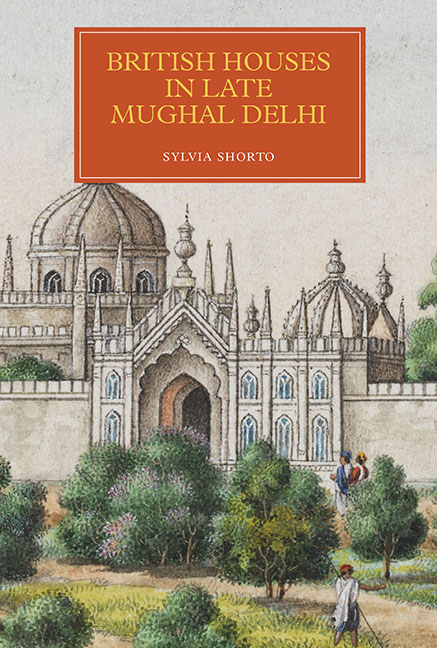Book contents
- Frontmatter
- Dedication
- Contents
- List of Illustrations
- Preface and Acknowledgements
- Abbreviations
- Glossary
- Map
- Chapter 1 Knowledge of Delhi: The Eighteenth Century
- Chapter 2 Hybrid Accommodations: David Ochterlony, the First Residency and the Mubarak Bagh
- Chapter 3 A Lovely Wilderness: Charles Metcalfe and the Garden Houses at Shalimar
- Chapter 4 Truly Fairy Palaces: Robert Smith in Delhi and in Europe
- Chapter 5 The World Displayed: William Fraser and his House on the Hill
- Chapter 6 A Tomb with View: Thomas Theophilus Metcalfe's Dilkusha
- Chapter 7 Dreaming of Home
- Bibliography
- Index
- Miscellaneous Endmatter
Chapter 2 - Hybrid Accommodations: David Ochterlony, the First Residency and the Mubarak Bagh
Published online by Cambridge University Press: 07 July 2018
- Frontmatter
- Dedication
- Contents
- List of Illustrations
- Preface and Acknowledgements
- Abbreviations
- Glossary
- Map
- Chapter 1 Knowledge of Delhi: The Eighteenth Century
- Chapter 2 Hybrid Accommodations: David Ochterlony, the First Residency and the Mubarak Bagh
- Chapter 3 A Lovely Wilderness: Charles Metcalfe and the Garden Houses at Shalimar
- Chapter 4 Truly Fairy Palaces: Robert Smith in Delhi and in Europe
- Chapter 5 The World Displayed: William Fraser and his House on the Hill
- Chapter 6 A Tomb with View: Thomas Theophilus Metcalfe's Dilkusha
- Chapter 7 Dreaming of Home
- Bibliography
- Index
- Miscellaneous Endmatter
Summary
This chapter examines the building activities of the distinguished East India Company servant David Ochterlony (1758–1825), twice British Resident at Delhi and often cited as the paradigm of a man who effortlessly (and colourfully) straddled British and Indian culture. By 1803, Ochterlony had already been many years in India, and he brought to the post of Resident both the pragmatism of a soldier and the mentality of a colonial aristocrat. Indianised in his habits and lifestyle, he consciously emulated the manners of Delhi's urban aristocracy, reflecting in both his public and private roles the behaviour of the elites of a country in which had lived and worked for nearly fifty uninterrupted years by the time of his death in 1825. The chapter begins by looking at the establishment of the first Delhi Residency, a house Ochterlony occupied immediately after conquest in 1803. The Residency was located in part of an appropriated sub-imperial Mughal palace inside the walled city of Shahjahanabad, and I suggest reasons for the choice of this site and its meaning in the visual landscape of the Mughal city, both before and after conquest, linking its location to ideas of symbolic capital. I then compare the Residency with what we know of other houses built by Ochterlony in Delhi and elsewhere in north India, focussing on the Mubarak Bagh, a garden house in a fanciful blend of Mughal and neo-Gothic styles, part of which was perhaps also intended for use as his mausoleum. Viewed through the lens of Ochterlony's very particular life, a comparison of these two houses – the one public and reused, the other private and newly built – begins to illustrate the permeable ways that heterogeneous style, form and function merged in British houses in late Mughal Delhi.
David Ochterlony, already an established officer in the Company's army, had been Adjutant General under the British commander Gerard Lake in the second Anglo-Maratha war. He was rewarded for his service by appointment to a first term as Delhi Resident between 1803 and 1806. During this time, much of his effort went towards forging a respectful relationship with the Emperor, Shah Alam II, and to following the protocols of the Mughal court. ‘The mode in which Lt. Col.
- Type
- Chapter
- Information
- British Houses in Late Mughal Delhi , pp. 25 - 54Publisher: Boydell & BrewerPrint publication year: 2018

